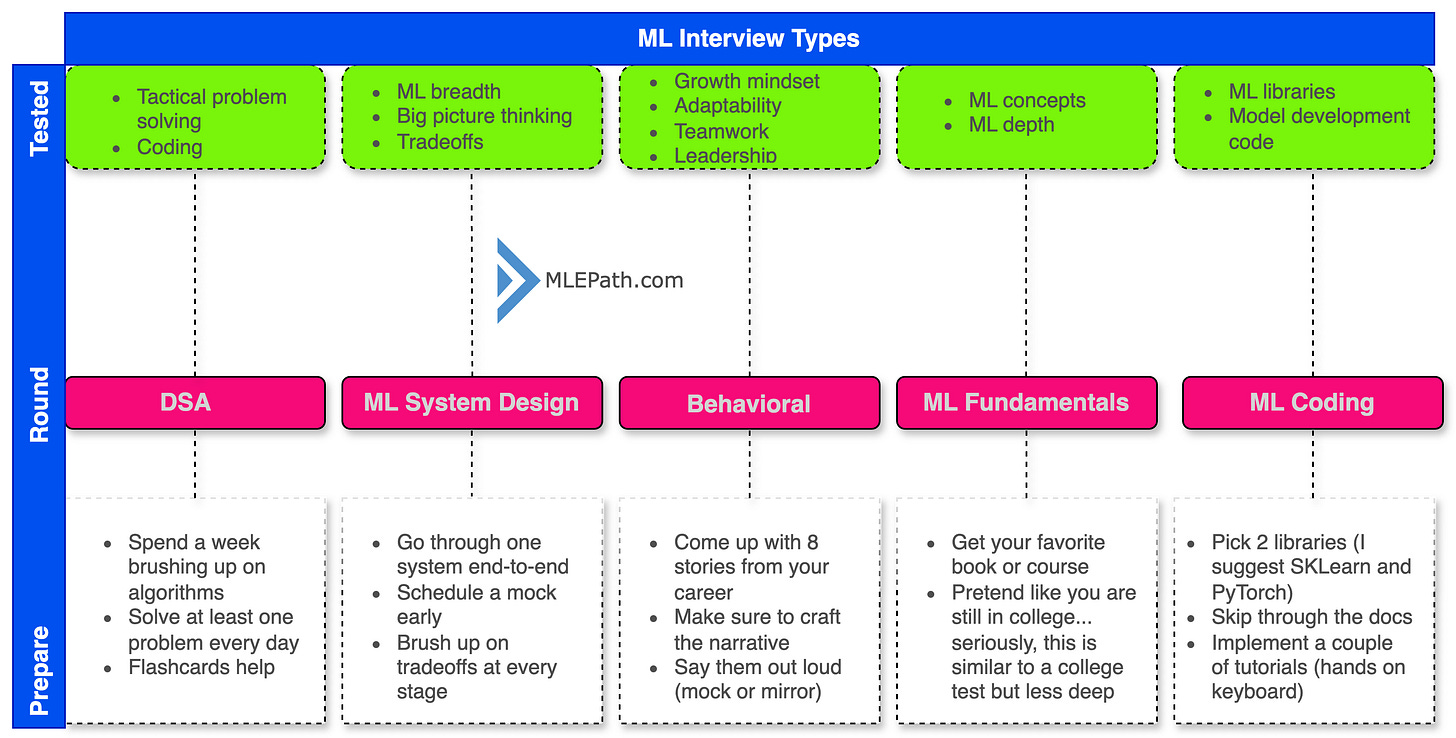Pass ML Engineer Interviews in 2025
I helped 150 ML engineers get hired this year. This is what you should know about the MLE interviews
In 2024 I helped over 150 people land their dream ML jobs at big tech companies through my one-on-one mocks, classes, and cohorts. My students ranged from entry level to principal engineer with majority being staff-level. But alas, it takes too long to help everyone one-on-one, so here are the things you should know if you are interviewing for ML Engineer in 2025.
Why Do ML Interviews Even Exist?
Before diving in, let’s tackle the big question: Why are these interviews so freaking complicated?
If I had to guess, it’s because companies have been burned before. They’ve hired folks who’re brilliant in one dimension (math geniuses who can’t ship) or in another (implementation wizards who don’t understand what they’re implementing).
When you think about it, an ML interview is a behavior and skill proxy. Are you able to collaborate, communicate, and solve problems in real time? Do you freak out and focus on the parts you love (like micro-tuning a dropout layer) but ignore the bigger picture? Companies want to know that, if they give you a gnarly ML puzzle, you’ll come through with something that both runs and makes sense.
Why You Might Not Be Passing
1. The Hiring Process Is Weird (Sometimes Arbitrary)
I once applied to Twitter with a referral—heard absolutely zilch. A month later, a recruiter reached out for the exact same role, and this time I magically became a “perfect fit.” Same resume, same me. So if you’ve been turned down and you’re left scratching your head, realize the process can be, well…slightly arbitrary. Companies might be filling a pool of general ML hires (like Meta or Google) or they might be looking for a very specific candidate. If your nemesis in that pool happens to be Geoff Hinton (hey, a person can dream), then you’re probably toast—no matter how good you are.
2. You Don’t Actually Know What They’re Asking
When I was Head of MLOps at a Series B startup, I interviewed a candidate who sounded like a walking textbook. They rattled off ideal solutions for hypothetical problems but never once mentioned what they’d personally done. In a behavioral interview, that’s a recipe for a quick exit. Interviewers want to hear your real-life war stories, how you navigated a mess, and what you learned from it. If everything seems too neat and tidy—like you’re reading a Wikipedia page—it raises red flags.
The 5 Types of ML Interviews
If you’re not crystal-clear on the different interview types, you might be blindsided by something completely unexpected. Let’s lay them out:
1. Data Structures & Algorithms
• The old faithful of software interviews. You’ll be given some puzzle, and your job is to code a working solution. Yes, your final answer matters, but how you think matters even more.
2. ML System Design
• A more advanced, big-picture conversation about how you’d architect a machine learning solution end-to-end. Do you know how to handle training data, model deployment, scaling, or versioning?
3. Behavioral
• Aka “the meltdown round” for folks who’ve never had to talk about themselves. If you can’t walk me through how you tackled a real fiasco, overcame adversity, or navigated a weird team dynamic, it’ll show. This is where your authenticity shines—or falls flat.
4. ML Fundamentals
• Think: college exam. You might get grilled on the trade-offs between gradient descent variants, or asked about the bias-variance trade-off. Some big companies skip this, but many smaller ones will ask you to teach them ML in 45 minutes.
5. ML Coding
• A rising star in the interview world. They’ll have you fiddle with real code: debug a Pytorch snippet or throw together a quick pipeline in scikit-learn. This is where you show that you can actually stand up an ML solution without banging your head against the keyboard for hours.
How to Study (Without Losing Your Mind)
Data Structures & Algorithms
• Spend at least a week getting your Python basics and core algorithms in order.
• Leetcode practice, sure—but do it in a disciplined way: if you don’t see a solution in 3–5 minutes, peek, then revisit that problem a few days later.
ML Fundamentals
• This one can be “college test-y,” so if it’s all Greek to you, sign up for a Coursera or MIT OpenCourseWare refresher.
• My personal hack? Listen to audio lectures while doing chores. You’d be surprised how much you can absorb washing dishes.
ML Coding
• Brush up on scikit-learn and Pytorch. Think of these interviews like an on-the-job demo.
• If you haven’t done deep learning, you might need a couple of months to ramp. Don’t rush it.
Behavioral
• Craft about 8 stories from your career highlighting leadership, teamwork, problem-solving, and adaptability.
• Get messy. We learn more from mistakes and messy scenarios than from perfect, frictionless successes.
ML System Design
• A good starting point is this video where I go through how I would answer an ML System design question.
P.S. There won’t be office hours for the next two weeks. Take some time off and I will see you again next year! (There will still be a newsletter next week)



